Shiness: The Lightning Kingdom – A Troubled World
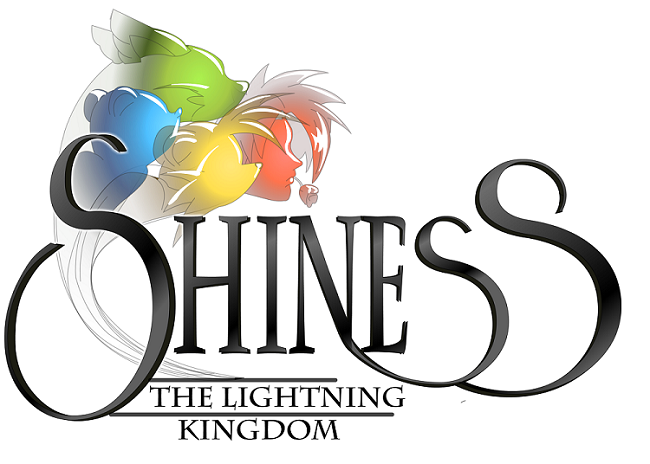
An Embattled Beauty
Shiness: The Lightining Kingdom was created by the French indie studio Enigami. While published by the well recognized company that is Focus Home Interactive, this would be the ambitious first project for Enigami. Going to Kickstarter in May of 2014, the game eventually earned a bit over 130,000 dollars, surpassing it's 100,000 goal.
This impressive-looking game would follow a fellowship of mixed creatures, mostly focused on the character Chado, a Waki – a furry, bipedal creature that may be part squirrel, but I was never really sure. Chado has a chip on his shoulders, but is never really angst-ridden like many JRPG protagonists, and he has the rare ability to see spirit creatures called the Shiness. Getting advice and often talking with his Shiness pal Terra, Chado eventually feels like an outcast in his own town, so he grabs an airship and takes off with his mechanic pal Poky. Eventually you meet more characters to add to the party as the gang quests to find The Lands of Life.
The game promised to be a strange hybrid. A few parts arena fighting game, a splash of manga, and a dose of JRPG. For what it’s worth, Enigami delivered on the intention. After having its release date pushed back several times, Shiness: The Lightining Kingdom finally arrived in April of 2017 at the price of $29.99 USD – and is available on Steam, Xbox One and PS4.
For my part I leaned back and pursed my lips, trying to determine what I thought of – and expected of – this strange sounding game.
The repeated impression I got was it was going to be a bit like the later Final Fantasy games in that it would do away with a more traditional turn based combat system, and rely on more of an action combat system, allowing our heroes to hack and slash and button mash their way to victory. But I kept seeing the mention of combos, and it made me curious. It looked like the game was going to be leaning more towards fighting games like Mortal Kombat or Tekken.
So that is what we got, including a contrived elemental barricade that prevents us from leaving the arena, and a strange unspoken tag-team style of combat that was oddly implemented. While I wanted to get in and explore the beautiful looking world of Shiness I was constantly routed in my efforts by the frustrating fighting system and some strange design choices.
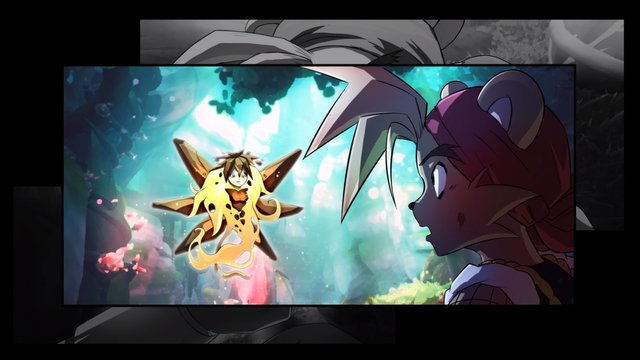
Flight or Fight
So, dear readers, your buddy Old Man Mordaith is a lover – not a fighter. Nothing really illustrates this more than my lukewarm relationship with fighting games. To say that Shiness leans heavily on the fight genre is a bit misleading. Rather than lean, it tries to saunter over with acrobatic grace and trips and falls, making all the other kids have a good laugh at it's expense.
While wandering the world of Shiness, I’d sometimes come across some lovingly created monsters – many of whom must suffer from chronic nearsightedness, as they seemed to have the same perception skills that I do without my glasses. When combat starts however, these nearly blind goons turn in to full on blood thirsty kill machines. We are suddenly encased in a glowing force field that keeps changing colour, and need to fight to the death with these elemental based monstrosities. The game really wants you to be able to take note of all the pretty colours on display, so you can use corresponding elemental attacks and learn all manner of combos to advance.
Unfortunately for a player like me, Shiness lacks a difficulty setting. Maybe I’m wrong – I looked high and low – I could not find anything that would make this game more accessible difficultly-wise. As it is, the combat system is absolutely not a rewarding experience for players like myself.
Just making it clear here that I am not a fan of the game’s fighting mechanics. They want a guy, who is still slightly afraid of his smartphone, to track colours, sync them with the proper spells, while learning to dodge, parry and memorize all the different combos for all the different characters with uber-precise timing? I'm sorry, the misery inflicting learning curve maybe fun for those that enjoy the idea of a colourful and fun Dark Souls game, but not for me.
And even if you do learn all the combos, they’re easily broken by enemy attacks. In fact, most of the enemies are unfairly relentless in combat. Many times when I started out, I found myself overwhelmed before I could even get a handle on the controls. Most of the time I was unable to effectively block, parry, or dodge, and when I somehow pulled it off I wasn’t able to launch into anything more than a flailing button mashing excuse of a counter attack. Fortunately, yes, you can pause the game and look at your combo list. However that really doesn't make it any better when the combos seem to require more luck than skill to get off.
What would have made the fight system better was a working targeting system. The idea behind a target locking system is to help players – it prevents them from being disoriented in a fast paced fight and losing sight of their enemy. I quickly became disappointed with the targeting system in this game, as it was consistently unlocking the camera and doing the complete opposite of its intended job of helping me stay oriented in a fight. For players like me, who are used to a less frantic style of fighting, this was a wasted opportunity. Really, unless they plan on fixing the way it functions, it is a mystery why it was ever added in the first place.
A shore of sanity in this fight mess are Hyper moves. You build your tension bar by beating up bad guys with all your kicks and punches (not combos – that will deplete the bar), and eventually you earn enough tension to pull of a Hyper move. You enter hyper mode with a button and things slow down. You now are prompted to enter a button sequence that will activate a brief cinematic attack which deals a great amount of damage. These look cool, they’re easy to use, and they’re clearly explained. Unlike pretty much everything else in the fight system.
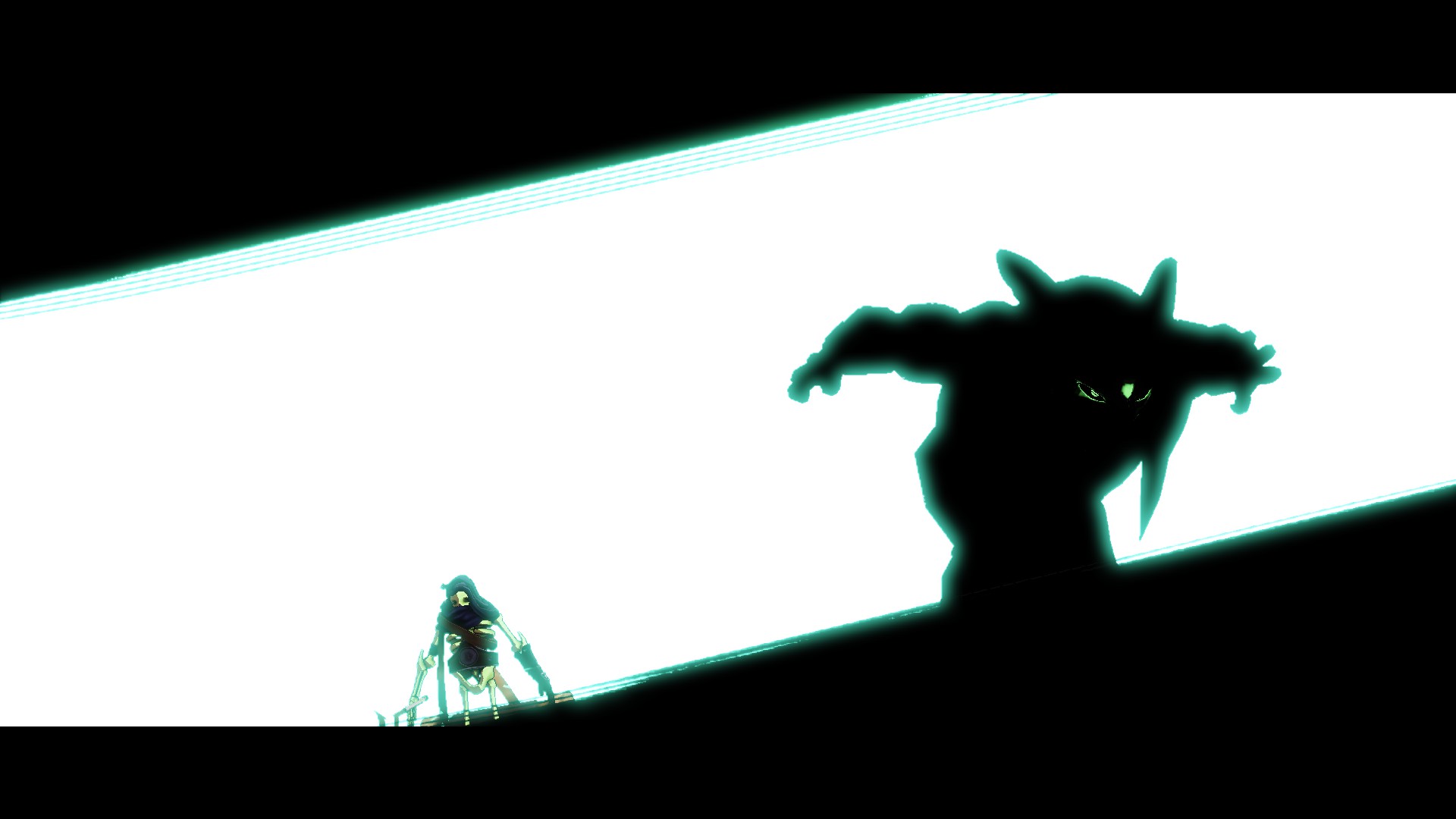
Unfortunately, you often have to choose one of the following: Defend yourself, make use of your combos, or build up for that ultimate attack. This is because parrying, combos, and Hyper moves are all dependent on the same resource. The system would have been much better if Hyper moves were based on damage that you received, like they are in many other games, and combos were not dependant on any resource at all. Why make a combo based system, and restrict when you can use them?
I gave my complaints about the fighting system a great deal of thought before putting them down. While fighting games are not something I really play much of anymore, they are something I will pick up. I enjoy the characters, the special moves when I can manage them, and yes – I absolutely mean it – the story. The Mortal Kombat series remains one of my most beloved franchises and Injustice was fantastic, and you can bet your boots I'll be playing Injustice 2. But with this in mind, I'm bad at fightings. They aren't really made for my play-style. I recognize that and I can accept fighting game mechanics if it is in the pursuit of an enjoyable story and some fun characters. The fact I wasn't able to get past the fight mechanics in this game is telling of the problems within it.
There was earnest interest on my part to get to know Chado and the gang while uncovering the mysteries that Shiness offered. The fighting system drained me of this desire, like messing up a hyper move drained my tension bar.
Switching characters in battle is problematic in a few regards. First, if you accidentally switch to the next character in your line up (a simple mistake that happens often in the button-mashing fury of an inexperienced player like myself), your strategy goes out the window. Not only that but you are likely to be subject to the same initial overwhelming beating that your first fighter had endured. The second issue is when you try to do it on purpose. It seems that, like with consumables and combos, if you are recovering from a blow you can’t actually switch characters. Not the end of the world, I suppose, but it’s frustrating when you are desperately trying to switch to a better suited character but you just keep getting the beat down.
Before I move on from discussing the combat, I’d like to make a special closing note on one of the first major fights: The battle against the enemy Zagrom. In addition to being brutally difficult, to the point where I would still call it the hardest fight in the game, you needed to sit through the worst insult battle I've ever seen. Between the sweeping unskippable camera shots of a crowd of jeering idiot monsters and being forced to choose from a list of insults that were just gibberish that made no sense to me, but apparently were common vernacular among the characters, it was one of the most painful sequences I had to bear through in any video game to date. If I had bought this game, I would have quit there, demanded my money back, and likely played some good fighting games just to spite it.
I should add that I had to do the Zagrom thing six times. There are witnesses to confirm that this began no small amount of binge drinking. Seriously, the things I do for you kids.
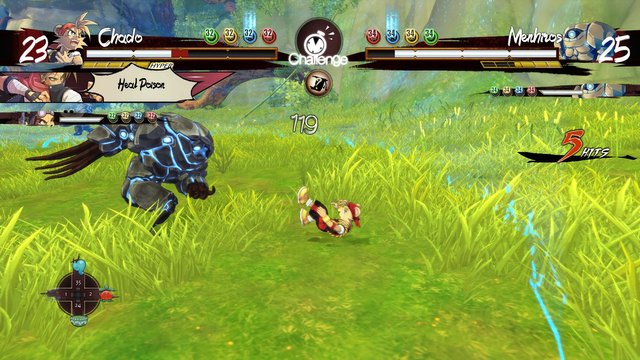
Gearing Up
One thing you can say about Shiness is that it’s not low on stuff to gather. Gear, Craftable Items, and Consumables abound in this semi-open world experience. Gear and Consumables are on par for importance in this game. The various items your characters equip modify their stats in a variety of ways, and some allow access to new combos and spells. It functions off a simple mastery system that I quickly recognized from other role playing games. Equip the gear, use the skill, and the skill mastery bar fills. Once it’s mastered, you retain the skill without need of the equipment. Repeat this with as many powers as you can, balancing the fact that gear you find early on will be weaker, so sometimes learning an old power can hamper you.
Consumables are vital in this game and, if they were not so much of a pain to use, they might have made the combat system more bearable for me. As with practically any other thing you do in combat, using a consumable requires exactly the right timing. If you are recovering from a hit, stunned, or suffering any other number of things that cause you to hesitate just that little bit in combat, you can’t use your all important healing fruit. Many fights I watched with growing disdain as my health bar dwindled from being tossed around like a rag doll, all as I tried to button mash healing consumables and blocking, neither successfully.
So many fights would have changed from “painful and frustrating” to “resource consuming but challenging” if a more forgiving consumable system was in place. But that is just my old brain talking – who knows what misery you young ones like to inflict on yourselves.
There are also a large amount of “Junk Items” in the game. These items can be sold for quick cash, or held on to so you can craft them in to other objects. These new objects fall into the previous two categories, so crafting is pretty useful. It was important enough that I felt obligated to do it, but it was not complex enough to make it a chore. The hardest thing about it was chasing some of the wily non-aggressive mobs before they literally vanished in a puff of smoke. Going through and selling them was a bit of a pain as well, as it made me feel like I was cleaning out an old junk drawer, constantly wondering “Where the heck did this come from – or fall off of?”
One last thing that seems like it should have been beefed up a bit is the Support system. Support skills are unlocked through various means. Each character who is not actively in combat, but is in your core party of three, can be assigned up to four support roles. These roles check under a series of triggers mostly related to enemy strength, ally strength, or the type of magical barrier in the area.
When I started unlocking them, I thought the Support system was going to be a game changer. It wasn't. The triggers were just not varied enough to have a meaningful impact on combat, and things like healing just didn't make a major difference. When you start regenerating maybe a dozen hit points over a beat or two of combat, but are being punched for four times that amount? It really is just delaying the inevitable.
The support system needs expanding – I'd keep my eye on this area of the game, and really strongly urge the company to take a look at it, as many of the combat system’s shortcoming could be made up for with a stronger support system.
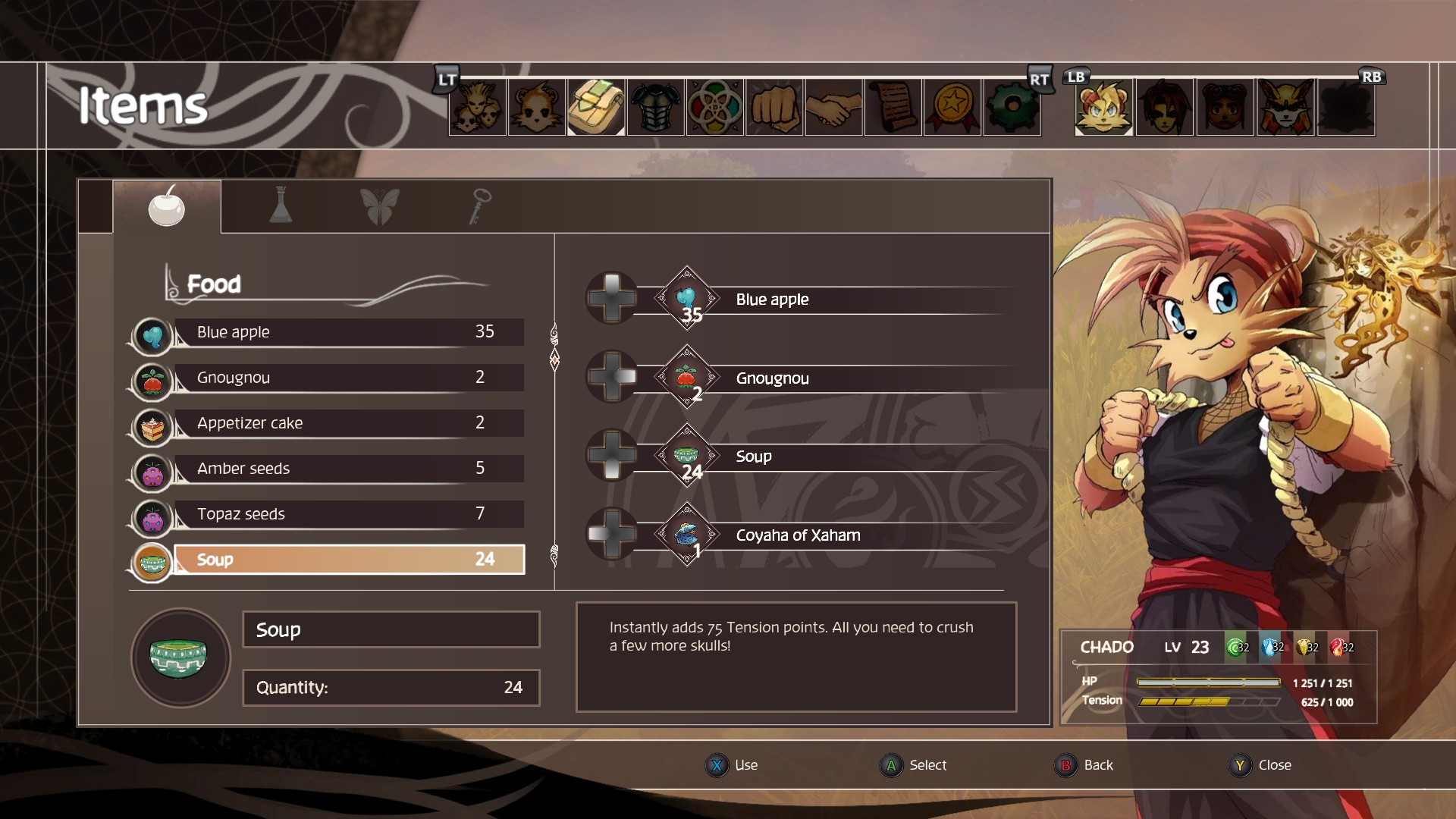
A Journey into Mediocrity
While combat was a huge part of this game, there are other aspects that need to be explored. And what better way to explore than with a map? The world map is actually fairly easily laid out. Nothing shocking here, just many games tend to butcher this important part of an game, vital to one where you can run around and explore.
Sadly, just being accessible isn’t enough. In general it was easy to get my bearings after the combat camera spun me around like I was about to whack a Waki shaped pinata, but it had a couple of problems. The game set up several blockades that were not removed until story appropriate times – these were not clearly marked on the map, so I bumped in to many “Dead Ends” while looking around. In the same vein, varied terrain height could be difficult to read on the map. But the biggest issue was elevation in general. Multi-levelled areas don’t really give you a good indication of where points of interest were, which led to a few frustrating moments. Nothing that sank this ship for me like combat did, though.
The story of Shiness is fairly familiar for those who know their basic vanilla high fantasy settings. Questionably motivated kingdom, plucky resistance, airships, wandering monsters, and elements playing a religious part of the setting.
Really, stop me if you've heard this before.
Actually, there’s a surprising amount of depth here. Sadly, the world is a victim of it's own creation. They really wanted to make something unique, even to the point of creating their own language. However, with all the various terms, peoples, and colloquialisms, it’s easy to get confused. A lexicon would have been handy, but a “Fish Out of Water” character that we could have learned the world through would have been a better solution without giving up on any setting depth. The game would have been so much more palatable if Chado had lost his memory in the initial airship crash, and he had to relearn everything with help of his friends as they slowly revealed his own motivations to him.
Being honest, by the end of things, I could have done with the a bit of amnesia.
The voice acting could be politely described as rickety. I love JRPGs, but as any fan is going to tell you the voice acting is not top notch in them. Even in the newer and widely successful Final Fantasy 15, the voice acting is a bit cringeworthy at some points. So I tend to be pretty forgiving in this area.
With this game you are not signing on for any spectacular performances, but boy will the subtitles confuse you. Sometimes the characters say one thing, and a completely different set of words crop up in the subs. Amusing at first, but whenever it happens it really distracts from the scene, particularly dramatic ones. Disabling them, if you prefer, may save you a bit of brow furrowing.
Interacting with objects and characters you meet is a pain. You need to be standing at just the right way in many cases to get the prompt to talk/use. Mercy be upon you if there is an informative description on an object that also has an interactive use – you will be slowly moving back and forth trying to find that sweet spot where it will either have a Question Mark symbol or an interaction prompt. That, combined with obnoxiously slow ladder climbing animation, made for some very irritating sequences in the game. I have enough trouble getting up and down ladders in real life, I don't need to be reminded of that when I immerse myself in to a digital furry suit.
Lastly, a word about the save game system. It uses a save point system, so you run up, talk to the cute little “memory eater” NPC and save your game with them. However, they are pretty much everywhere. And I mean everywhere. In many map areas you can see two or three in the same close proximity. Save your game, run down an empty hallway, and oh- there is another one, may as well save again.
If they were going to be that plentiful, just let the player save when ever they want. Most major fights have a save spot right before, so I'm unsure why this system was needed.
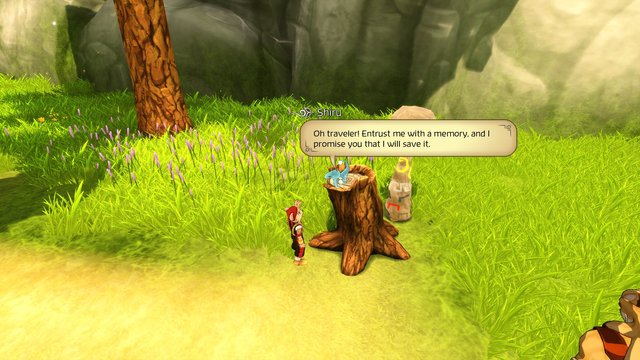
Sunshine in a Stormy Land
It wasn't all bad. In addition to excellent music, the graphics are all top-notch, the world is lovingly crafted, character design is fantastic, and the creatures all have an interesting look to them. It’s too bad that presentation alone doesn’t save a poorly designed system.
There is one element I haven't touched on yet, and that is the puzzles. I was so conflicted over the puzzles, and I still am unsure of why I am left with the opinion on them that I have.
Puzzle games, much like platformers, are not really my thing. Frustration is not what I play video games for. Some do, I don't. Each character in this game has a "Special Ability" and these are solely for the purpose of solving puzzles. What I expected to be the most hated part of the game for me, became an oasis from the miserable experiences I had in combat. And I don't know what to make of it.
I am honestly confused here, gang... I haven't actively enjoyed a puzzle game since the Dr. Brain series.
Well, make no mistake that the abilities your characters get to solve puzzles with have absolutely zero real bearing in exploration. Your telekinetic can’t flip switches, nor can your strong character pick up blocks to move them. This really punches you out of the immersion and reminds you this is a game, there are rules! These abilities have no impact in exploration except in the capacity that solving a puzzle will allow you to progress through an area.
Allow me to explain with the strange example of Poky and Kayenne. Like other aspects of this game, I anticipated liking one, and hating the other, only to have the opposite occur.
Kayenne is a cool character, a tough telekinetic martial artist. Really up my alley. His puzzle solving ability was just that, really cool telekinesis. You could target specific objects marked with a rune, move them around with shocking freedom, and figure out the puzzles. Sadly, it was underused. His role in puzzles was a very dull affair. Most of them involved moving a block around, something I think any of the characters could likely have done with brute force. Really, I felt like everyone was just being nice to him and letting him show off his telekinesis – even Kayenne mentions that he can use his powers to stun people in a fight, but prefers to just punch them.
Poky, being the most irritating character, had what looked like the most insipid puzzle mechanic: He would run up to a Shi energy node, whack it with a tool, drag a beam of light to a nearby crystal or connection point, and connect them for various effects. It boiled down to a lot of running around, guessing games, and figuring out what happens when you effectively flicked various switches. I tell you, these became the most satisfying parts of the game for me. I would start to feel a weird sense of relief when I'd see a pulsating Shi energy node. I worry that my enjoyment of these puzzles was simply because it broke me away from the combat of the game.
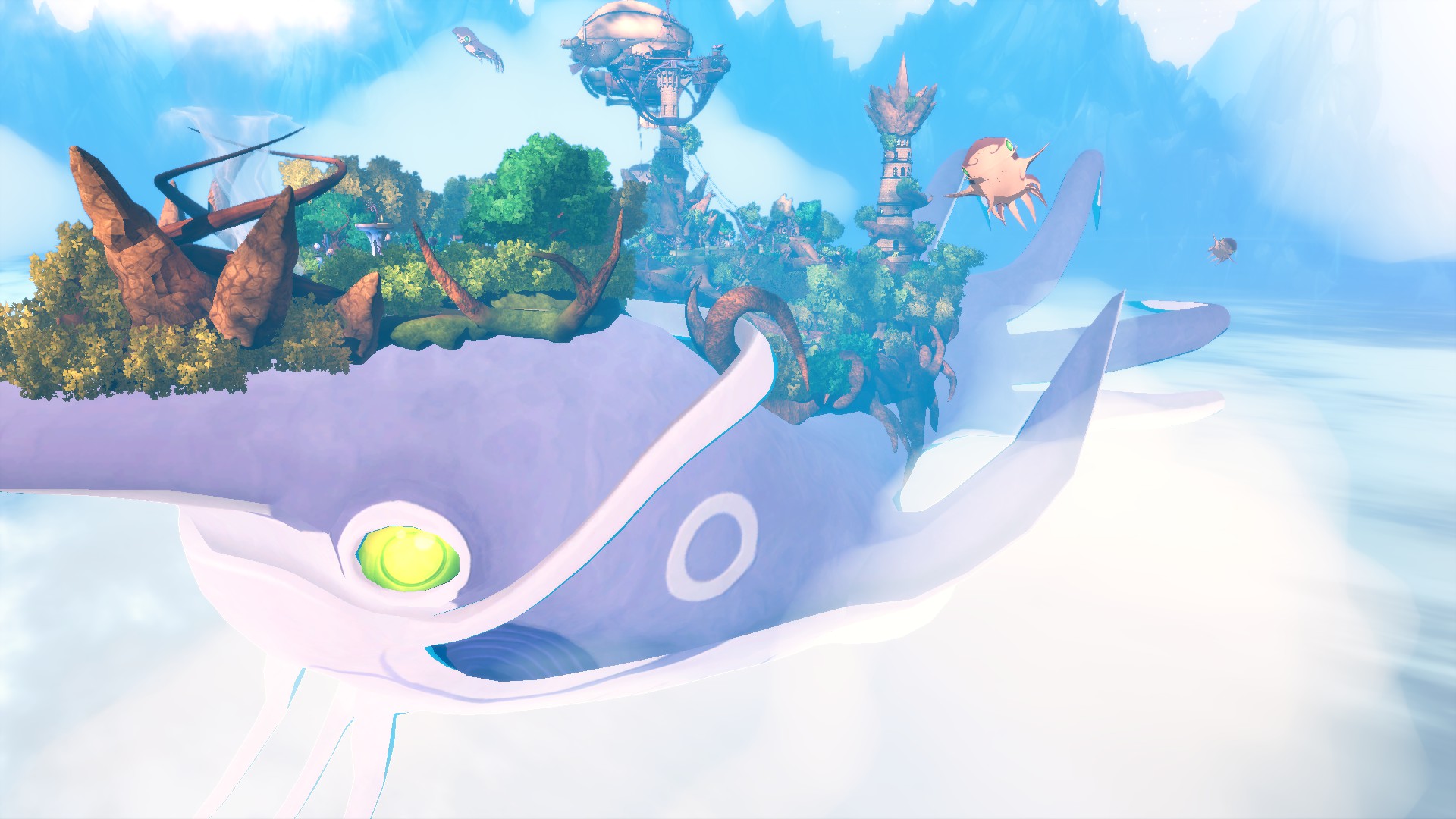
The Room From Hell
So there was a room. A room that nicely sums up my experiences with Shiness: The Lightning Kingdom. I will avoid posting in-depth spoilers, but in one of the later areas of Act I you come to a room where you need to climb a ladder, traverse an obnoxious path that is easy to fall from, and need to get the right angle to do a puzzle. Each time you fell, you would need to once again find the sweet spot to be able to interact with the ladder.
Then endure the slow climbing animation only to carefully try to traverse the platform again.
Then, maybe you'll luck out with your angle and get the simple puzzle to work.
Oh, did I mention, sometimes if you fell there were monsters waiting for you? Sometimes three – three hard ones.
And being the terrible noob I am, I fell often.
And that is a summary of my experience with the game: Struggling to interact with it, slowly climbing above painful and poorly executed combat mechanics, only to be suddenly and irritatingly be brought back down to them. All the while trying very hard to get to the brief moments of worthwhile exploration and puzzles.
While I do not know the under-the-hood mechanics of the game, there is a lot of tweaking here that could be done. In my review I made several observations that if even one was followed, would have made the game a much more enjoyable experience for myself.
This game has some very loud and proud fans, and good for them. I, however, am not one of them.
Rating 5.5/10
Review by Joshua Smith aka Old Man Mordaith
Edited by Jesse Roberts
This game was received for free, for the purpose of review.
This article may not be republished without permission.
Congratulations @oldmanmordaith! You have completed some achievement on Steemit and have been rewarded with new badge(s) :
Click on any badge to view your own Board of Honor on SteemitBoard.
For more information about SteemitBoard, click here
If you no longer want to receive notifications, reply to this comment with the word
STOPwill this game be free to play?
Not to my knowledge. I think it is a single player game only.
Its a shame. :/ anyway...nice descriptive review there...:)